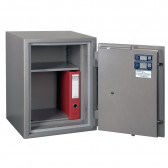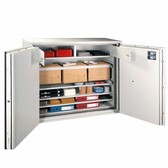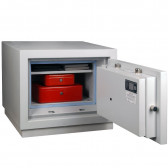A safe is not just a solid cache of valuables. Today there are so many safe models available that cash and valuables, as well as important documents, data carriers, electronic equipment and weapons can be safely stored in them. There is also a wide choice of safety classes, fire resistance and installation methods. We will tell you how to choose a safe which is best suited to your home.
How to choose a safe – step by step
The number of safe models available on the market is so large that you can deposit any valuable items in them. Thinking about its future contents should be the first step towards choosing the right safe. First of all, we need to define our needs. If the main purpose of a safe is to protect valuables against theft, we should opt for an anti-burglary model (PN-EN 1143-1). If the most important task is to protect against potential fire and flooding, it is better to choose a fireproof safe. However, the first type of safe will not protect the contents against fire. In the latter case, fire resistance can last up to 120 minutes at temperatures of up to 1090 degrees Celsius and the safe can remain in the hot charred remains of the building for up to 24 hours after a fire (according to the PN-EN 1047-1 standard). There are safe models on the market which combine both functions, and since we usually buy a safe for many years, it is worth not saving on your own safety and pay a little more to gain double protection.
Safe class and burglary resistance level
The potential contents of the safe will also be an indicator of the class of burglary safe we should choose. The numbered class from 0 to XIII determines the upper limit of values that can be deposited in the safe, and this is particularly important when we want to insure possessions. The higher the class, the more resistant the safe is to attempted burglary. For example, the last, highest classes are used in vaults. Additional solutions in the form of, for example, an alarm increase the degree of security and the permissible monetary limit which can be deposited inside.
This may interest you: A unique ID safe – what is it?
How to install the safe and its size
The next step when choosing a safe should be to match the appropriate model and its size to the possibilities of the premises. Not every safe can be installed in a flat or house. Safes can be placed in furniture, hidden in a wall or fixed to the floor, for example in a study. Furniture safes are often chosen for their small size and easy concealment. Wall safes, on the other hand, require a special recess in the wall in order to be installed. This is because they need to be encased in concrete at least 100 mm thick, which means that they not only require structural work but also sufficiently thick walls. It is therefore advisable to plan for this type of safe as early as the planning stage of your home. Other models include free-standing safes such as cabinet safes, gun cabinets and burglar-proof safes, which can be placed in any room that is not accessible to the public. Sometimes the current and future needs are so great that it is worth setting up a vault room in the house, where large, valuable items such as works of art can be safely stored.
How to choose a safe – summary
When choosing the best safe for your home, you should also consider the additional security features and type of locks that will best suit your needs. A certified safe of high quality will resist attempts to break in and will not be able to be taken out by a thief. It is therefore worth betting on a solid model from a proven manufacturer, which will guarantee a good investment for years. Since a safe is an investment in your own security, it is worth choosing a reputable supplier, who has a long tradition of presence in the market, giving a guarantee of further operation of the company. This will provide us with support and trusted service not only during the warranty period, but also many years after purchase.
Check out the most popular furniture safes.





